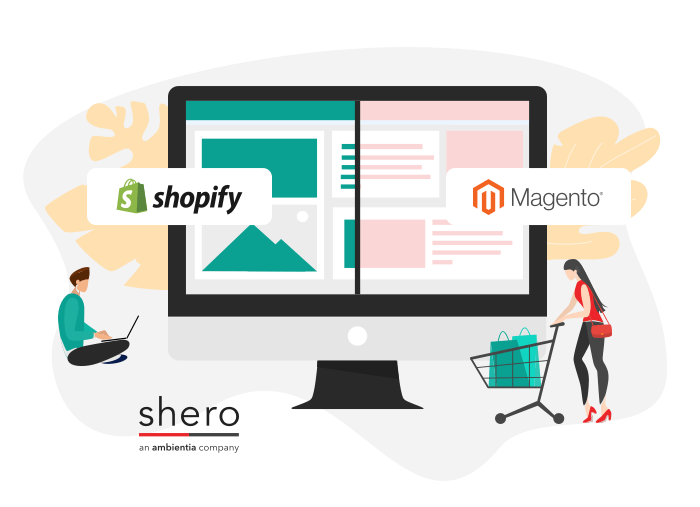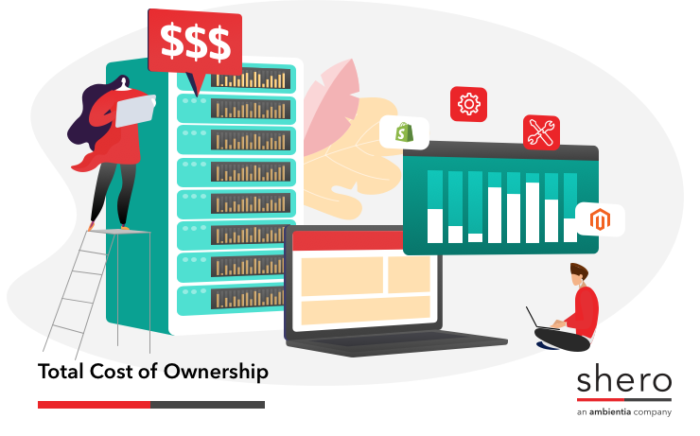Are you contemplating between Shopify Plus vs. Adobe Commerce (Magento) for your eCommerce platform? The decision isn’t as straightforward as it may seem. Each platform offers unique advantages and costs, and the best choice depends on your specific requirements and budget.
In this guide, we’ll dig into a detailed comparison of Shopify vs. Magento, focusing on the total cost of ownership (TCO) and the key factors to consider when deciding on which platform.
Table of contents

Why does choosing the right eCommerce platform matter?
As an entrepreneur or eCommerce manager, your choice of platform is a critical business decision. It directly influences your company’s growth trajectory and success. The ideal platform should align with your operational needs, target market, and business objectives.
If you’re an online-only business, your eCommerce platform is your business’s backbone. For multi-channel businesses, your eCommerce website could outperform your physical stores, contributing significantly to your annual revenue. For B2B and wholesale businesses, your website could be your main sales tool.
Let’s review first what are Shopify Plus and Magento 2.
Introduction to Shopify Plus and Magento 2
What is Shopify Plus?
Shopify Plus is a more advanced version of regular Shopify, designed for high-growth enterprises and large businesses, aimed at high-volume merchants who need a scalable solution with low technical overhead.
According to BuiltWith, as of July 2023, over 42000 websites worldwide use Shopify Plus.
What are some advantages of Shopify Plus?
With Shopify Plus, businesses can benefit from robust functionalities like multi-channel integration, customization capabilities, comprehensive 24/7 support, access to customizable checkouts, additional API calls, unlimited user accounts, and advanced apps to enhance their stores.
As an enterprise-level plan, Shopify Plus offers several benefits for high-volume businesses. These include:
- Unlimited bandwidth, reliable servers, and full payment compliance, thus providing an all-inclusive and totally reliable system
- Full access to CSS and JavaScript control and the Script Editor
- Designed to handle high traffic volumes
- Dedicated account manager to help businesses with their online store
- Predictable and cost-effective monthly fee that allows businesses to make changes fast with a small, nimble team for less time and money
- Designed as a global solution that allows businesses to easily sell internationally across different platforms
What are some disadvantages of Shopify Plus?
Despite its benefits, Shopify Plus has limitations like high cost, with a monthly fee of $2,000, which can be a significant expense for small businesses.
Additionally, integrating some third-party apps with Shopify Plus can incur an extra charge, increasing the overall cost. Furthermore, Shopify Plus lacks a multi-store architecture.
The only way to open multiple Shopify stores is by creating an account for each one. For more complex stores, technical debt is possible, which can also be a disadvantage of using Shopify Plus.
Although Shopify Plus offers more customization options than regular Shopify plans, it still has some limitations regarding customization.
Lastly, Shopify Plus can be difficult for businesses that require multiple order processing.
| Plan | Cost per Month | Features |
|---|---|---|
| Shopify Plus | $2000+ | Designed for high-volume businesses, offers enterprise-level features |
| Advanced Shopify | $299 | Includes all features of lower plans, plus advanced report building and third-party calculated shipping rates |
| Shopify | $79 | Includes all features of Basic plan, plus gift cards, professional reports, and abandoned cart recovery |
| Basic Shopify | $29 | Includes basic features needed to set up an online store, such as website and blog creation, unlimited products, and 24/7 support |
What is Adobe Commerce (Magento)?
Adobe Commerce is a cloud-based version of the Magento platform fully integrated with Adobe tools like Analytics Cloud, Marketing Cloud, and Advertising Cloud.
It is a flexible and scalable end-to-end eCommerce platform that allows personalizing, managing, and optimizing the commerce experience. Adobe Commerce comes with all the Magento open-source features and includes many additional capabilities and tools, such as B2B features, business intelligence dashboards, marketing tools, content management, and more.
Unlike Shopify, which has seen huge growth in the last few years, Magento’s popularity has gradually declined.
WebsiteBuilder.org reports that Magento (Adobe Commerce) has a 12% market share among the top 1 million sites on the internet.
What are some advantages of Magento?
Magento shines with its vast range of customizable features.
With its ability to handle high volumes of traffic and transactions, Magento is an ideal choice for businesses aiming to scale rapidly. It comes out of the box with robust features like advanced search, layered navigation, and versatile product options that empower merchants to create a tailored and dynamic online store.
The platform prioritizes SEO, providing optimized URLs, sitemaps, and meta tags to improve your store’s visibility in search engine rankings.
Magento’s multi-store capability simplifies managing multiple stores across different regions, languages, or product ranges.
Adobe regularly releases security measures (patches) and version upgrades.
Magento can be integrated with various third-party services, including payment gateways, database applications, ERPs, DAMs, shipping, shipment tracking.
Its extensive global community of developers and agencies (the Magento Community) ensures businesses can find innovative solutions for their needs.
What are some disadvantages of Magento?
While there are many advantages to using Magento as your eCommerce platform, there are also a number of disadvantages when compared with Shopify. Overall, Magento demands significant technical expertise. The development and maintenance costs can be high, and its complex interface may prove daunting for non-tech-savvy users.
Unless you have coding experience or an in-house team, you may experience high development and maintenance costs and a steep learning curve. By design, Magento is very convoluted, and its structure is complex.
As a result, Magento can be time-consuming to set up and customize, which can delay the launch of your eCommerce store. Furthermore, finding experienced developers/Magento agencies can be difficult, and their fees are generally higher than those of Shopify developers/agencies.
Pricing and Total Cost of Ownership (TCO) Comparison: Shopify Plus vs Magento

Factors Contributing to TCO
When considering a new platform, it’s crucial to understand and budget for the total cost of ownership (TCO). The TCO of a Shopify Plus or Magento store typically includes expenses like platform licensing cost, hosting, apps or extensions, third-party services, maintenance & support, future feature development, and future platform upgrades.
The Importance of Budgeting for TCO
Most merchants start by looking at the initial build cost. Although initial build cost is important as it’s typically a large upfront expense, it’s only one element to consider.
Depending on your business operations, you may also need to consider the ongoing maintenance, hosting, and upgrades cost, (especially for Magento), and the cost of training your team on your new platform, hiring additional qualified staff, and marketing.
Shopify Plus vs. Magento Commerce Licence Pricing, Subscription, and Hosting Costs
Magento’s Pricing Structure
Magento offers a number of options, including a Magento Commerce on-premise (choose your own hosting environment), Magento Commerce Cloud (hosted by Adobe), and the free Open Source edition. The Commerce edition is tiered based on Gross Merchandise Value (GMV), with hosting starting at $200. The Commerce Cloud edition costs $2,000–$5,000/month for GMV less than $10M/year, with hosting included.
Shopify’s Pricing Structure
Shopify also offers several options. The Shopify Lite plan costs $9/month, the Basic Shopify plan is $29/month, the regular Shopify plan is $79/month, and the Advanced Shopify plan is $299/month. The Shopify Plus plan costs $2,000/month for GMV less than $10M/year. All plans come with hosting included.
However, if your revenue exceeds $800K a month, Shopify Plus implements a revenue share model. In these months, you will be charged 0.25% of your monthly revenue, but only for the amount exceeding $800K.
Both Magento and Shopify offer a number of options.
| Vendor | Edition | Price | Hosting Price |
|---|---|---|---|
| Magento | Open Source | Free | $200 and up |
| Magento | Commerce (On-Prem) | Tiered pricing based on Gross Merchandise Value (GMV) | $200 and up |
| Magento | Commerce Cloud | $2,000–$5,000/month for GVM less than $10M/year | Included |
| Shopify | Shopify Lite | $9/month | Included |
| Shopify | Basic Shopify | $29/month | Included |
| Shopify | Shopify | $79/month | Included |
| Shopify | Advanced Shopify | $299/month | Included |
| Shopify | Shopify Plus | $2,000/month for GVM less than $10M/year | Included |
The Cost of Building a Store: Magento vs Shopify Plus
With the rapid evolution of technology, we’ve found that most websites are redesigned every four to five years. While a re-platform is not a redesign requirement, if your business is growing, a redesign presents an opportunity to reevaluate platform options that may better support continued growth. Having built hundreds of websites on both the Shopify and Magento platforms over the past 13 years, here is what you should expect to pay for each platform:
The Basic Cost of Building a Magento Store
As discussed above, Magento’s strength lies in its ability for nearly limitless customization and code/website ownership. As a merchant, you have full access to the code of your website and can customize it in any way you see fit.
Magento is built with a programming language called PHP on top of the powerful Zend Framework. As a merchant, you’ll have full access to the code of your website. You can host the site wherever you want and customize the code however you see fit.
Developers can overwrite and extend Magento’s built-in functionality and perform direct operations on the entire database.
Dynamic functionality can be added to Magento through customizations or by installing extensions from Magento’s Marketplace.
The Marketplace offers a variety of extensions that Magento has independently validated. Verified extensions are open, and their code can be modified or customized. And if you can’t find an existing extension to customize, Magento developers can custom-build one.
In short, with Magento, you have unparalleled customization options, and if you can’t find a feature you need, you can build it.
However, building a Magento site requires highly skilled and preferably Magento-certified developers who understand both frontend and backend technologies and how they interact with the platform.
Whether you’ll be using Magento Open Source or Magento Commerce, the cost of a Magento website will be similar and depend on the amount of custom development required and the number of integrations with third-party systems.
Therefore, project costs can range from a few thousand dollars for a simple Magento site with basic functionality (configure Magento, install a theme, connect shipping and payment gateway solutions, and import products) and up to $50,000-$100,000 or more for a more complex, heavily customized site.
On the other hand, Magento Commerce starts at $22,000 per year for the platform license alone, and total costs can easily exceed $100,000 or even $300,000 when development, hosting, and ongoing maintenance are factored in.
The Basic Cost of Building a Shopify Store
Shopify’s greatest strengths are simplicity, low technical overhead, and go-to-market speed.
Shopify is built with a programming language called Ruby, on top of the popular Ruby on Rails framework.
Shopify development is limited to the front end, which means fewer elements can be accidentally broken, and this gives Shopify parameters by which they can optimize their hosting performance.
In practical terms, though, the programming language doesn’t matter because Shopify doesn’t allow you to modify the backend code.
Instead, Shopify themes are built with Liquid, a frontend templating language developed by Shopify, which inherits some language constructs from Ruby.
But there’s a significant benefit to these limitations. These restrictions allow Shopify to generate essentially static files which are easily cacheable and, therefore, highly performant.
While Shopify development doesn’t require the same niche expertise that Magento development does, it should not be overlooked.
Much of the development happens on the front end during any site build, regardless of platform. Because of Shopify’s technical limitations, front-end developers may need creative problem-solving to accomplish your goals, whether with custom development or using a Shopify App.
While Magento allows you to install extensions alongside core code, dynamic functionality can only be added to Shopify via apps. These distributed micro-services often rely on assets and data hosted on third-party servers.
Shopify’s App Store offers many ready-made solutions for your Shopify store. Some third-party services also offer private Shopify apps, which are only available via the service provider.
Like Magento, custom-built Shopify apps can provide entirely unique functionality if you can’t find what you need. Thanks to Shopify’s rich REST API, almost anything can be done on the platform.
Shopify Plus offers a flexible pricing structure based on your monthly revenue. For example, if your revenue is up to $800K a month, you will be charged a flat rate of $2000 per month.
The cost of a fully functional but basic Shopify website for a small business typically ranges from $5,000 to $20,000+. However, this price can vary depending on your specific Shopify plan and other factors.
When you opt for Shopify Plus as your platform, your investment will bring you valuable benefits. With a minimum monthly fee of $2,000, you’ll join a community of merchants who have found success within this price range.
The average cost for a Shopify Plus site typically ranges from $60,000 to $200,000+, depending on project scope and website complexity.
While there may be no significant difference between the other Shopify plans and Shopify Plus, the price difference to note for building a Shopify site on Shopify Plus comes from the fact that merchants/brands who use Shopify Plus have more established businesses with advanced design requirements, complex catalogs, and a plethora of integrations.
Key Takeaways:
Shopify and Magento offer comparative options for merchants with annual online sales below $1M. For sales above $1M, though, higher licensing costs for Magento Commerce and additional hosting and optimization costs for Magento Open Source make Magento a more expensive option than Shopify.
Magento builds will usually be more expensive than Shopify builds because Magento development requires a team of highly skilled individuals. However, Shopify has limitations that may be expensive to work around.
Magento will typically be more expensive to support than Shopify because Magento development requires a larger investment in platform and infrastructure maintenance. Generally, Shopify websites are less susceptible to downtime or security breaches.
Both platforms offer a range of features, but the availability of certain “out of the box” features may vary.
Maintenance and Support Costs: Magento vs Shopify

Magento’s Maintenance and Support Costs
Maintaining a Magento site can be a complex task requiring a skilled developer team. The platform’s open-source nature allows for extensive customization but requires regular updates and patches to ensure security and performance. From our experience, Magento maintenance costs range from $3500 to $10,000 per month.
These costs usually come as a retainer where the relationship is focused more on technical support first and then strategy if the agency offers such services. When hiring an agency like Shero, we dedicate a team of developers, QA, account management, and project management to the specific account. Usually, a 6-month roadmap is created, and the merchant works with their dedicated team on an ongoing basis to keep their site secure, do version upgrades, and release new features.
Shopify’s Maintenance and Support Costs
On the other hand, Shopify, as a hosted solution, doesn’t require version upgrades or maintenance. Shopify itself handles such support. This can result in lower costs for these services compared to Magento.
Complex and larger brands on Shopify Plus usually have extensive customizations on their sites or have specific needs not covered by Shopify’s standard offerings and support. These needs include ERP integrations, apps, or services connected to Shopify but independently maintained.
That said, Shopify Plus maintenance ranges from $3,500 to $10,000, but the focus is more on marketing initiatives like creative work, new feature releases, AB testing, SEO improvements, and integration fine-tuning.
For many merchants, Shopify’s appeal lies in its simplicity and lower technical costs. The primary drawback of creating custom-built Shopify apps or reverse engineering Shopify is that you’re adding a layer of technical complexity and raising the platform’s total cost of ownership.
That makes complex customizations impractical for many merchants. If that’s the case, you should consider another platform like Magento.
The main difference between the two platforms’ maintenance costs is that with Shopify, the spend is more ROI driven, while with Magento, merchants tend to feel that spending on upgrades and patches is a waste of money. As an agency, we are stuck in the middle. Believe me, we’d rather do the fun work with Shopify vs. doing repetitive patches and upgrades on Magento.
A Headless Shopify Plus Or Magento Approach
A common buzzword we hear time and again when speaking to new merchants is “Headless Commerce,” where the front end of your site has been decoupled and removed from the back end and operates independently. Therefore, I am including a section about headless because going headless with your Magento or Shopify Plus website makes measuring TCO almost impossible. Now, why is that, you may wonder?
First, unless you have to go the headless route, I would discourage it. While headless sounds amazing, you are creating a lot of complexity and interdependencies in your eCommerce platform that comes with a heavy price to implement and maintain long-term.
Second, one of the main reasons to go with Shopify Plus is the reliability of the platform and the long-term cost savings from not having to spend money on version upgrades and patches. The same goes for Magento. On top of keeping up with the decoupled architecture, you’ll have to make sure Magento version upgrades and patches are applied.
Lastly, you’ll need a very experienced team internally to manage the project and an agency with a proven track record of implementing headless websites. Going headless works naturally against maintaining a low TCO and speed to market.
Yet, if you have your mind set on headless commerce, here are some of the pros and cons:
Headless Commerce Pros:
With a headless approach, you have more flexibility. You can design your front end without any limitations imposed by the back end. This allows for high customization and flexibility in design and user experience.
Headless websites are usually fast and often deliver content faster than traditional setups. This is because the front end (the “head”) can be hosted on a Content Delivery Network (CDN), which can serve content quickly and efficiently.
As your business grows, a headless approach can make it easier to scale your operations. You can upgrade or modify your backend without affecting the front end, and vice versa.
Headless commerce separates the front end and back end, making it easier to deliver a consistent experience across multiple channels (e.g., web, mobile).
Headless Commerce Cons:
Implementing a headless architecture can be more complex than a traditional setup. It requires a strong development team with knowledge of both frontend and backend technologies.
Due to the increased complexity, setting up and maintaining a headless website can be more expensive than a traditional one.
While not insurmountable, SEO can be more challenging with a headless setup. This is because some features that help with SEO (like meta tags and structured data) need to be manually managed.
Traditional eCommerce platforms like Shopify and Magento often come with various features (like checkout and payment gateways) that are ready to use. With a headless setup, out-of-the-box features are lacking and may need to be custom-built, which can take more time, resources, and cost (TCO).
Magento vs. Shopify Features Comparison
Here’s a comparison of commonly used features available “out of the box” in Magento 2 and Shopify Plus. This list doesn’t outline every feature available, but we recommend starting here.
| Feature | Magento | Shopify |
|---|---|---|
| Wishlist | Built-in | Requires app |
| Blog | Requires extension | Built-in |
| Coupon Codes | Built-in | Built-in |
| Paypal Express | Built-in | Built-in |
| Apple Pay | Requires extension | Built-in |
| Amazon Pay | Requires extension | Built-in |
| Authorize.net | Requires extension | Built-in Shop Pay, Apple Pay, Google Pay, Amazon Pay |
| Google Analytics | Built-in | Built-in |
| URL Redirects | Built-in | Requires app |
| Product Comparison | Built-in | Requires app |
| Related Products | Built-in | Requires theme modification |
Find a full list of features and independent costs for each platform in our Magento Pricing Guide and Shopify Pricing Guide.
What would the TCO look like for Magento vs Shopify Plus?
For a side-by-side TCO comparison of both Shopify Plus and Magento, please see below:
| Cost Factor | Shopify Plus | Magento 2 |
|---|---|---|
| Platform and Hosting Costs | Starts at $2000/month, includes hosting | Varies based on version (Open Source, Commerce On-Prem, or Commerce Cloud) and hosting solution |
| Build Costs | Generally less expensive as it requires less technical expertise | Generally more expensive due to the need for a team of highly skilled individuals |
| Maintenance & Support Costs | Unparalleled customization options and features can be added through extensions or custom development. | Higher, as Magento requires a larger investment in platform and infrastructure maintenance |
| Features | Some features require apps or custom development | Unparalleled customization options and features can be added through extensions or custom development. |
| Cost Type | Shopify Plus | Magento |
|---|---|---|
| App/Extension Costs | Varies | Varies |
| Transaction Fees | Applies if not using Shopify Payments | None |
| International Selling Costs | Additional costs may apply | None |
| Hosting | Included | Varies |
| Development | $95 to $185 per hour | $95 to $185 per hour |
| Upgrades | None (Handle by Shopify) | Requires developer assistance |
| Security | None (Handle by Shopify) | Requires regular updates and patches |
| SEO | May require additional resources or services | May require additional resources or services |
Conclusion
The Winner Is: In the battle between Shopify Plus and Magento’s total cost of ownership, Magento builds will usually be more expensive than Shopify builds because Magento development requires a team of highly skilled individuals. For the reasons we discussed above, ongoing maintenance costs will also be higher for Magento.
However, Shopify has limitations that may be expensive to work around, but ongoing maintenance and support costs for Shopify will be generally lower. With Shopify Plus, there are no platform upgrades and patches, thus allowing merchants to redirect that budget toward a more measurable ROI.
In 2023, unless you had a specific need to go with Magento (selling firearms or a product that Shopify doesn’t allow on their platform or are a heavily B2B focused business) nine times out of ten, we would recommend Shopify as the better platform with the lower long-term total cost of ownership. This is all assuming that you’d be willing to compromise, give up some of the Magento customizability and flexibility, and work within the parameters of the Shopify platform.
In conclusion, the choice between Shopify Plus and Magento should be based on a thorough analysis of your needs and budgetary considerations. While Shopify offers scalability and simplicity, Adobe Commerce’s Magento focuses on customization and integration capabilities. By carefully evaluating factors such as the total cost of ownership, scalability requirements, desired level of customization, and integration needs, you can make an informed decision that aligns with your business goals.
We encourage you to take advantage of trial periods, demos, and consultations with each platform’s representatives to gain firsthand insights into how each platform aligns with your business objectives.
If you need help deciding between the two, please don’t hesitate to reach out to discuss your options with our team of experts.
- Magento Open Source was previously referred to as Magento Community Edition.
- Magento Commerce Cloud was previously referred to as Magento Enterprise Edition. It’s also offered as an on-premise solution for similar licensing costs.
- Magento Commerce Cloud pricing is tiered based on annual online revenue or “GMV” (e.g., Gross Merchandise Value). Higher GMV equates to a more expensive licensing cost.
- Shopify Plus pricing is based on monthly Eligible Platform Transactions (EPT). The cost is $2,000/month or 0.25% of EPT, whichever is higher, with a maximum cost of $40,000/month (roughly $16M EPT)
Gentian, CSO and co-founder of Shero Commerce, guides the company and client digital strategies. He's an expert in technical SEO, Inbound Marketing, and eCommerce strategy.






